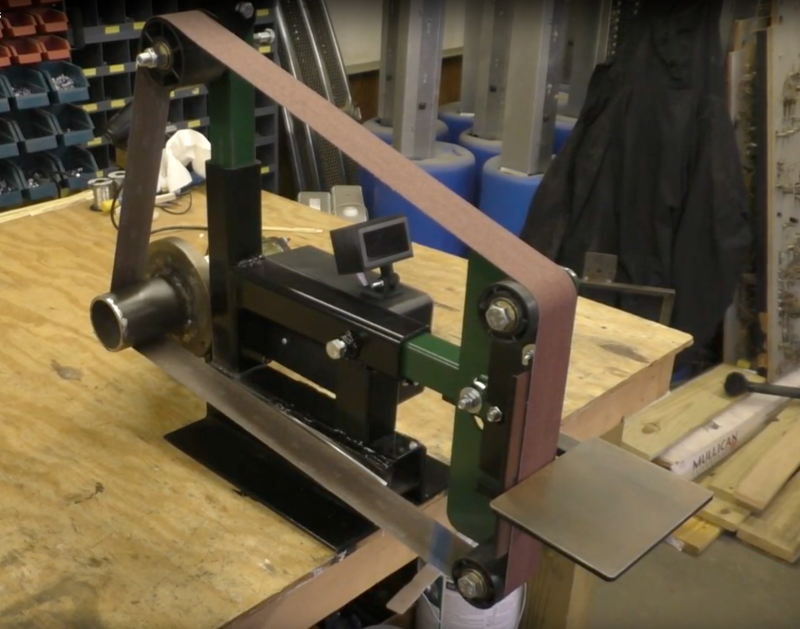We’re just over a month into the new year, and some people’s resolve on those exercise plans are already dwindling. There’s some good news though. That treadmill can be hacked into a nice belt grinder for your shop.
[Bob]’s treadmill belt grinder is based on a 2.5 horsepower motor he salvaged from a broken, donated treadmill. This motor needs 130 VDC to run, which is a bit of a challenge to generate. Fortunately, lots of treadmills seem to use the same MC-60 motor controller, which is compatible with this motor. Due to the widespread use of this controller, they can be found on eBay for about $30.
With the motor spinning, [Bob] built up a frame for the grinder, added rollers to hold the belt, and a spring based belt tensioner. The motor’s speed set point is controlled by a potentiometer, and the controller varies the power to keep a constant speed. Since the motor is capable of some serious RPM, a tachometer was added for feedback to prevent high-speed belt shredding.
The final result is a very professional looking tool for under $200. What would a grinder like this be used for? Knives of course! 2″ belt grinders are perfect for shaping and grinding knives and swords. In fact, you can see one in use in this sword hack.
Check out a video of the build after the break.
















God damned video by habit I close eyes when welding happens.
130VDC (or close enough) is actually super easy to make — feed 120VAC into a full-wave rectifier (no capacitor!) and you get 120VDC; there’s a ton of 120Hz ripple in there, but the motor won’t care. If you want 2-speed capability, throw a switch in to switch between full-wave and half-wave rectification.
Don’t like all that 120Hz hum? Well then, add a big honkin’ filter cap (not forgetting a bleeder resistor!), and you get 170VDC with low ripple, exactly how low depends on how big your capacitor is. To bring that down to 130V max, you can either PWM it on the DC side (which you were probably gonna do for speed control, right?), or put a variac on the AC side (clear winner in the days before power transistors overran the world, and also gives you speed control).
That’s not how it works, that’s not how any of it works. Ever heard of peak and RMS voltage?
PS okay, I read on about the “honkin’ filter cap”. Still, a bit over-simplified.
But that’s the great thing — motors don’t care! That “over-simplified” description (and you’re right, it is) is all you need, because DC motors are incredibly robust with regards to things like half-sine waveforms or PWMing them from a (much) higher bus voltage, as long as you keep the duty cycle low enough.
I’m just trying to combat the notion that “needs 130 VDC to run, which is a bit of a challenge to generate.” Sure, a clean 130V DC power supply is a bit of a challenge, but that’s not what you need to run a 130V DC motor.
but who has120VAC…:-) I’d need an extension cord the the USA…
Alright then, foreigner, grab yer big honkin’ filter cap and full-wave rectifier, and rectify your 230VAC (I assume?) mains for about 325VDC. PWM that; as long as you keep the duty cycle correspondingly low, the motor won’t care. (Within reason — obviously at some point the winding insulation breaks down from overvoltage, but a 130V motor will handle 325V peak.)
(Or the variac thing, just restricting the variac setting to 40% max instead of 80%. But like I said, nobody likes variacs anymore, because FETs are smaller, lighter, and cheaper; I just mention it because I think they’re cool.)
I have and like a variac. When I have to test a SMPS or audio amp it’s very good to slowly ramp up the voltage and watch the current. So you see if you have missed a fault which would blow up the new power transistor again. Otherwise you are possibly back to square one.
I am sure this (generate variable 50Hz AC voltage) can be done with FETs too, but not as robust as a variac. And sometimes you also want an isolation transformer for safer working.
For a belt grinder I would probably use a TRIAC control (light dimmer) in front of the rectifier.
2.5 HP for a belt grinder? Isn’t that overkill?
When you don’t want to spend 4 hours grinding a knife, no, it’s not :D
Dont think i have ever used a power tool and thought , this could use less torque, but i have lost count of the number of tines i have thought the opposite lol
:-) Sure.
The only imaginable reason for wanting less power draw would be a weak power source (small generator in the field).
2.5 hp for a little bitty belt sander should be sufficient! That’s more than a Citroen, I think.
the Citroen 2CV (2hp in french) name was referring to “Tax Horsepower”, a small vehicle category in France. The smallest engine gave 9hp, 29hp for the biggest engine.
Now this is an awesome hack.
Three things.
First, never wear gloves around rotating machinery especially drill presses.
Second, welding steel to cast iron with generic mig wire will probably not last long. The welds will be extremely hard from carbon pulled out of the cast and it is just a matter of time before the pulley breaks off.
Last, you need crown on at least a couple of the idlers to keep it in place. Thats why he is having a heck of a time with tracking.
my father in law wants to get back into knifemaking.
his wife has a treadmill that goes largely unused.
How auspicious!